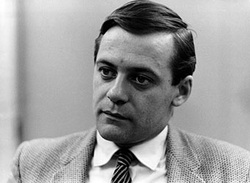
Much of the TSO’s contemporary programming is packed into its annual New Creations Festival. But other new works are scattered throughout the season on “normal” concerts.
But Triptyque was written in 1959 – and it’s now more than half a century old. Audiences have had plenty of time to assimilate this and other modernist works from the 20th century. Yet with many mid-20th century composers, such as Mercure, no such assimilation has really taken place. If this music still sounds shiny and new in the year 2012, it’s because it has acquired so little of the cultural patina that comes with familiarity and acceptance. Modernism’s cadres like to say that this music remains “challenging” to audiences. Those who aren’t so enthusiastic might call it weird, alien, opaque or impenetrable.
Perhaps that’s why the audience, on Thursday evening, giggled when TSO music director Peter Oundjian claimed from the stage that Wednesday’s audience “went wild” over the piece. Not bloody likely.
Triptyque has its virtues: the nine-minute piece is well structured and masterfully orchestrated. Yet audience response was tepid. Of course, it might have helped if the TSO’s performance had been enthusiastic and vivid rather than dutiful and sombre. But even with an ideal performance it’s hard to imagine that many people (myself included) would have felt inclined to respond with anything beyond polite applause.
There is sometimes an admirable nobility in a sincere, high-minded and yet ultimately doomed enterprise. That nobility can, I think, be heard in Triptyque. But so can the wrongheadedness of a compositional movement that sought to overturn a culture’s most deeply held musical values in the quest for a new means of expression.
For more information on Mercure’s (tragically short) life and work, click here.
It was ironic that this TSO program ended with Shostakovich’s Symphony No. 12 – completed in 1961, two years later than Mercure’s essay. Today, Shostakovich stands out as one of the few composers from the modern era whose work has settled into the repertoire. Even if Shostakovich’s style was, in some ways, imposed by the demands of socialist realism, he evidently understood some things that “free” composers didn’t.
From Oundjian’s downbeat, the TSO’s playing was blunt and direct – which was a fine thing in the portions of this symphony that call for this approach. But in other places, long phrases were chopped up and subtleties were steamrollered.
Sandwiched between the two 20th-century works was Beethoven’s Triple Concerto. For this performance, the TSO brought together a disparate group of soloists: Jonathan Crow (the TSO’s concertmaster), Toronto cellist Shauna Rolston and Montreal pianist André Laplante. Each played admirably, but when they combined their efforts there was sometimes a skittish cautiousness in their performances. The most successful movement was the second, which was nicely balanced and elegant.
© Colin Eatock 2012
 RSS Feed
RSS Feed

